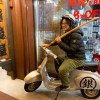Thousands stranded for hours during Japan’s peak holiday travel period.
As we edge closer towards the New Year, roads and public transport systems around Japan are now working at full capacity as people travel back to their hometowns to celebrate the most important holiday of the year with their families.
With so many people travelling at the moment, any breakdown or delay can quickly become a big problem, creating huge crowds and inconveniencing thousands of people in a short period of time.
So when the driver of the Tohoku and Yamagata-bound Yamabiko with Tsubasa 177 Shinkansen bullet train was unable to release the emergency brake at Tokyo Station at 9:50 a.m. on 30 December, the breakdown resulted in crowds like this.
東北新幹線北改札、子供の泣き声とアナウンスでガヤガヤ。一部で押すなの怒号飛び駅員から強い口調で入場規制の誘導。お疲れ様です。。。ホント。東京駅 新幹線乗り換え改札にて pic.twitter.com/2JbrTsGLKK
— 鈴木脩一 (@SHU1_SUZUKI) December 30, 2018
According to reports, the Shinkansen that broke down couldn’t be moved from its position at platform 23 for over an hour-and-a-half, which meant that other bullet trains heading in and out of the station were also affected.
▼ Crowds at the station at 11:00 a.m.
https://twitter.com/niiiiiifaaaaa/status/1079211832190001152▼ And at the platform at the same time.
すんごい混雑 @ 東京駅😲💦 pic.twitter.com/JrQp8zsRM0
— hilo_fu (@hiro_ldn_) December 30, 2018
▼ The situation still hadn’t changed at 2:00 p.m.
東京駅東北新幹線改札、現在でもこんな感じ。 pic.twitter.com/tjvPgltvqz
— 山内大地 (@O8PKQcQDe7EE7rc) December 30, 2018
By 3:00 p.m. in the afternoon, all trains on the Tohoku, Joetsu, Hokuriku, Yamagata and Akita Shinkansen lines were delayed by more than 90 minutes.
東京駅の東北新幹線のりば付近は
— ブルーミン (@246R_Bloomin) December 30, 2018
果てしない人ごみで、大変な状態やったわ pic.twitter.com/o4X9h67RUI
▼ Staff stepped in to restrict entry in order to control the ever-growing crowd.
東京駅ヤバすぎる
— トリミー (@torimiwa) December 30, 2018
入場規制 pic.twitter.com/SQyCg2yrAs
At 5:30 p.m., the situation still hadn’t improved, with two-hour-plus delays being reported.
東京駅東日本の新幹線、改札で入場規制かかっててヤヴァイ pic.twitter.com/01rzor3hzT
— のんたん (@catnontan) December 30, 2018
▼ It took this passenger 20 minutes just to get to the ticket gate.
東京駅混み過ぎてて20分かけてようやく新幹線の改札までたどり着いた pic.twitter.com/eQcbbGHgs7
— Takuma Kajikawa (@kajitack) December 30, 2018
▼ “More crowded than an amusement park”.
テーマパーク以上の混雑#東京駅 #東北新幹線 pic.twitter.com/SnQJdeZI9O
— Jun (@alohacamera808) December 30, 2018
▼ This passenger had one word for it: “Chaos“.
上越新幹線70分遅れカオスでした。
— nobo (@fatt_sharp) December 30, 2018
15分前には改札前にスタンバイした方が良さげすよ。誘導悪いのでゆっくり安全に前へ前へ。#上越新幹線 #東京駅 #新幹線 #遅延#帰省ラッシュ pic.twitter.com/RrsLwOLpHM
At 9:30 p.m., trains were still delayed, with many people wondering what time their last train, which usually departs before midnight, would actually depart.
2時間遅れでどうにか新幹線乗った🚅#遅延 #東京駅 pic.twitter.com/CRAPfW7898
— 早坂 伸 Shin Hayasaka (@shin_hayasaka) December 30, 2018
At 10:45 p.m, it was clear that the delays weren’t going to get any better before the final train of the day.
東京駅にいるけど、
— Pacific (@pacific0301) December 30, 2018
まだ新幹線のダイヤが
乱れている。
今22:45。 pic.twitter.com/C9BRp3QPtC
According to East Japan Railway Company, which operates the five affected Shinkansen lines, approximately 228,700 passengers were affected by the incident, with delays or suspensions on roughly 376 routes as a result.
With travel set to hit another peak on January 2 and 3, as people return from their hometowns, public transport is set to remain busy until Sunday 6 January, before the working year begins again.
Hopefully there’ll be no future setbacks for passengers during this period, but if there are longer delays than today, it might just create the perfect conditions for another impromptu station platform drinking party.
Source: Hachima Kikou
Featured image: Twitter/@alohangloose

 Commuter chaos around Tokyo during peak hour after Typhoon Trami hits Japan 【Pics & Video】
Commuter chaos around Tokyo during peak hour after Typhoon Trami hits Japan 【Pics & Video】 You can go surprisingly far on a single train leaving from Tokyo Station
You can go surprisingly far on a single train leaving from Tokyo Station Typhoon Trami batters Japan, hits close to Tokyo with fierce winds 【Photos & Videos】
Typhoon Trami batters Japan, hits close to Tokyo with fierce winds 【Photos & Videos】 Nozomi Shinkansen bullet train abolishes low-priced unreserved tickets during peak travel seasons
Nozomi Shinkansen bullet train abolishes low-priced unreserved tickets during peak travel seasons Tokyo snowfall, the heaviest in four years, causes chaos in the capital 【Photos】
Tokyo snowfall, the heaviest in four years, causes chaos in the capital 【Photos】 Foreigner’s request for help in Tokyo makes us sad for the state of society
Foreigner’s request for help in Tokyo makes us sad for the state of society Historical figures get manga makeovers from artists of Spy x Family, My Hero Academia and more
Historical figures get manga makeovers from artists of Spy x Family, My Hero Academia and more McDonald’s new Happy Meals offer up cute and practical Sanrio lifestyle goods
McDonald’s new Happy Meals offer up cute and practical Sanrio lifestyle goods Red light district sushi restaurant in Tokyo shows us just how wrong we were about it
Red light district sushi restaurant in Tokyo shows us just how wrong we were about it Anime girl English teacher Ellen-sensei becomes VTuber/VVTUber and NFT
Anime girl English teacher Ellen-sensei becomes VTuber/VVTUber and NFT Celebrate another year of life by putting it in jeopardy with this birthday candle flower
Celebrate another year of life by putting it in jeopardy with this birthday candle flower Japan’s massive matcha parfait weighs 6 kilos, contains hidden surprises for anyone who eats it
Japan’s massive matcha parfait weighs 6 kilos, contains hidden surprises for anyone who eats it Sandwiches fit for a sumo served up in Osaka【Taste Test】
Sandwiches fit for a sumo served up in Osaka【Taste Test】 Tokyo Tsukiji fish market site to be redeveloped with 50,000-seat stadium, hotel, shopping center
Tokyo Tsukiji fish market site to be redeveloped with 50,000-seat stadium, hotel, shopping center A Gintama fan’s emotional 19-year journey to buy a proper Lake Toya bokuto wooden katana【Pics】
A Gintama fan’s emotional 19-year journey to buy a proper Lake Toya bokuto wooden katana【Pics】 Japanese ramen restaurants under pressure from new yen banknotes
Japanese ramen restaurants under pressure from new yen banknotes All-you-can-drink Starbucks and amazing views part of Tokyo’s new 170 meter-high sky lounge
All-you-can-drink Starbucks and amazing views part of Tokyo’s new 170 meter-high sky lounge French Fries Bread in Tokyo’s Shibuya becomes a hit on social media
French Fries Bread in Tokyo’s Shibuya becomes a hit on social media Studio Ghibli releases new action figures featuring Nausicaä of the Valley of the Wind characters
Studio Ghibli releases new action figures featuring Nausicaä of the Valley of the Wind characters New private rooms on Tokaido Shinkansen change the way we travel from Tokyo to Kyoto
New private rooms on Tokaido Shinkansen change the way we travel from Tokyo to Kyoto Studio Ghibli glasses cases let anime characters keep an eye on your spectacles
Studio Ghibli glasses cases let anime characters keep an eye on your spectacles Beautiful Ghibli sealing wax kits let you create accessories and elegant letter decorations【Pics】
Beautiful Ghibli sealing wax kits let you create accessories and elegant letter decorations【Pics】 Studio Ghibli releases Kiki’s Delivery Service chocolate cake pouches in Japan
Studio Ghibli releases Kiki’s Delivery Service chocolate cake pouches in Japan New definition of “Japanese whiskey” goes into effect to prevent fakes from fooling overseas buyers
New definition of “Japanese whiskey” goes into effect to prevent fakes from fooling overseas buyers Our Japanese reporter visits Costco in the U.S., finds super American and very Japanese things
Our Japanese reporter visits Costco in the U.S., finds super American and very Japanese things Studio Ghibli unveils Mother’s Day gift set that captures the love in My Neighbour Totoro
Studio Ghibli unveils Mother’s Day gift set that captures the love in My Neighbour Totoro New Japanese KitKat flavour stars Sanrio characters, including Hello Kitty
New Japanese KitKat flavour stars Sanrio characters, including Hello Kitty More foreign tourists than ever before in history visited Japan last month
More foreign tourists than ever before in history visited Japan last month New Pokémon cakes let you eat your way through Pikachu and all the Eevee evolutions
New Pokémon cakes let you eat your way through Pikachu and all the Eevee evolutions Sales of Japan’s most convenient train ticket/shopping payment cards suspended indefinitely
Sales of Japan’s most convenient train ticket/shopping payment cards suspended indefinitely Sold-out Studio Ghibli desktop humidifiers are back so Totoro can help you through the dry season
Sold-out Studio Ghibli desktop humidifiers are back so Totoro can help you through the dry season Japanese government to make first change to romanization spelling rules since the 1950s
Japanese government to make first change to romanization spelling rules since the 1950s Ghibli founders Toshio Suzuki and Hayao Miyazaki contribute to Japanese whisky Totoro label design
Ghibli founders Toshio Suzuki and Hayao Miyazaki contribute to Japanese whisky Totoro label design Doraemon found buried at sea as scene from 1993 anime becomes real life【Photos】
Doraemon found buried at sea as scene from 1993 anime becomes real life【Photos】 Tokyo’s most famous Starbucks is closed
Tokyo’s most famous Starbucks is closed One Piece characters’ nationalities revealed, but fans have mixed opinions
One Piece characters’ nationalities revealed, but fans have mixed opinions We asked a Uniqlo employee what four things we should buy and their suggestions didn’t disappoint
We asked a Uniqlo employee what four things we should buy and their suggestions didn’t disappoint Princesses, fruits, and blacksmiths: Study reveals the 30 most unusual family names in Japan
Princesses, fruits, and blacksmiths: Study reveals the 30 most unusual family names in Japan Stranded passengers on Shinkansen bullet train served out-of-date bread during typhoon
Stranded passengers on Shinkansen bullet train served out-of-date bread during typhoon Japan’s number-one cosplayer is ready for hundreds of close-ups as she summons huge Comiket crowd
Japan’s number-one cosplayer is ready for hundreds of close-ups as she summons huge Comiket crowd Commuter chaos at Shibuya Station after glass window breaks on door of crowded Japanese train
Commuter chaos at Shibuya Station after glass window breaks on door of crowded Japanese train Osaka earthquake hits city during peak hour, passengers freed after trains suspended
Osaka earthquake hits city during peak hour, passengers freed after trains suspended Is the new Shinkansen Train Desk ticket worth it?
Is the new Shinkansen Train Desk ticket worth it? November snow falls in Tokyo for first time in 54 years, causes chaos for peak hour commuters
November snow falls in Tokyo for first time in 54 years, causes chaos for peak hour commuters The ultimate Shinkansen trip: Riding Japan’s bullet train network from one end to the other
The ultimate Shinkansen trip: Riding Japan’s bullet train network from one end to the other Kyoto train station thanks commuters for saving life of passenger who fell on the train tracks
Kyoto train station thanks commuters for saving life of passenger who fell on the train tracks Crabs take over electric signboard at Japanese train station
Crabs take over electric signboard at Japanese train station Gorgeous funicular route in China is so beautiful, it looks like something out of a movie【Video】
Gorgeous funicular route in China is so beautiful, it looks like something out of a movie【Video】 Talent agency frustrated at idol fans’ aggressiveness, tells them to stop on official website
Talent agency frustrated at idol fans’ aggressiveness, tells them to stop on official website Train driver’s locked tablet with forgotten password leads to big delay on Fukushima line
Train driver’s locked tablet with forgotten password leads to big delay on Fukushima line Notebook passed by hand from Hokkaido to Kagoshima, connects railway fans in heartwarming event
Notebook passed by hand from Hokkaido to Kagoshima, connects railway fans in heartwarming event Typhoon Jebi hits Japan, blows away cars, roofs, and building facades 【Pics & Videos】
Typhoon Jebi hits Japan, blows away cars, roofs, and building facades 【Pics & Videos】 Tokaido Shinkansen ending in-train food/drink sales for all non-first-class-passenger cars
Tokaido Shinkansen ending in-train food/drink sales for all non-first-class-passenger cars
Leave a Reply